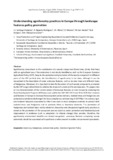JavaScript is disabled for your browser. Some features of this site may not work without it.
| dc.contributor.author | Santiago-Freijanes, Jose Javier | |
| dc.contributor.author | Santiago-Freijanes, Jose Javier | |
| dc.contributor.author | Aldrey, J. A. | |
| dc.contributor.author | Moreno, G. | |
| dc.contributor.author | den Herder, M. | |
| dc.contributor.author | Burgess, Paul | |
| dc.contributor.author | Mosquera-Losada, M. R. | |
| dc.date.accessioned | 2018-03-26T15:19:02Z | |
| dc.date.available | 2018-03-26T15:19:02Z | |
| dc.date.issued | 2018-02-17 | |
| dc.identifier.citation | JJ Santiago-Freijanes, A Rigueiro-Rodríguez, JA Aldrey, et al., Understanding agroforestry practices in Europe through landscape features policy promotion. Agroforestry Systems, August 2018, Volume 92, Issue 4, pp. 1105–1115 | en_UK |
| dc.identifier.issn | 0167-4366 | |
| dc.identifier.uri | https://doi.org/10.1007/s10457-018-0212-z | |
| dc.identifier.uri | http://dspace.lib.cranfield.ac.uk/handle/1826/13120 | |
| dc.description.abstract | Agroforestry understood as the combination of a woody component (forest tree, shrub, fruit tree) with an agricultural use of the understory is not clearly identified as such by the European Common Agricultural Policy (CAP). Despite the protection and promotion of the woody component in different parts of the CAP political text, the identification of agroforestry is not clear, although it can be recognised in the description of some landscape features, such as isolated trees and different types of hedgerows. Moreover, it is important to identify the extent of such woody components promoted by the CAP in agricultural lands to validate the impact of current and future measures. This paper aims at the characterisation of the current extent of landscape features all over Europe by analysing the Rural Development Program (RDP) measures within the CAP 2007–2013 and 2014–2020 that promote said features in Europe to increase the ecosystem service delivery. Isolated trees and hedgerows are protected unsatisfactorily through the Cross-compliance and Greening of CAP Pillar I. In contrast, Agri-environment measures associated to Pillar II are used in most European countries to protect both isolated trees and hedgerows and to promote them as boundary elements. The promotion of hedgerows and isolated trees mainly related to silvoarable and silvopastoral agroforestry practices is aimed at the promotion of the ecosystem services (such as water protection and biodiversity) and improvement in resilience (such as adaptation to climate change) they provide; therefore, the agroforestry environment benefits are indeed recognised. Landscape features comprising woody perennials should be associated with agroforestry when present in arable and permanent grasslands. | en_UK |
| dc.language.iso | en | en_UK |
| dc.publisher | Springer | en_UK |
| dc.rights | Attribution-NonCommercial 4.0 International | * |
| dc.rights.uri | http://creativecommons.org/licenses/by-nc/4.0/ | * |
| dc.subject | Inventory | en_UK |
| dc.subject | Hedgerows | en_UK |
| dc.subject | Isolated tree policy | en_UK |
| dc.subject | Common Agrarian policy | en_UK |
| dc.title | Understanding agroforestry practices in Europe through landscape features policy promotion | en_UK |
| dc.type | Article | en_UK |
Files in this item
The following license files are associated with this item:
This item appears in the following Collection(s)
-
Staff publications (SWEE) [2827]

